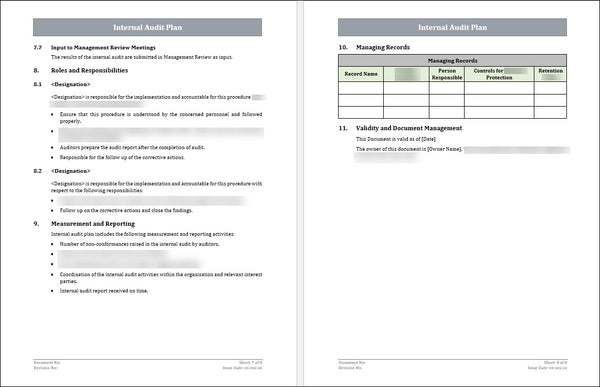ISO 9001 Internal Audit Plan Template
As organizations strive for quality management and continuous improvement, many turn to ISO 9001 certification to demonstrate their commitment to meeting customer expectations. However, achieving ISO 9001 compliance requires more than just implementing a quality management system. It also necessitates a robust internal audit plan to assess the effectiveness and efficiency of the system. In this blog, we will explore the key elements of an internal audit plan for ISO 9001, providing valuable insights and practical tips for successful internal audits.

Understanding the Importance of Internal Audits
Internal audits play a crucial role in ensuring the effectiveness of an ISO 9001 quality management system. They provide organizations with a systematic and objective assessment of their processes, identifying areas for improvement and verifying compliance with ISO 9001 requirements.
By conducting regular internal audits, organizations can uncover potential non-conformities before they become significant issues. This proactive approach helps to minimize risks, enhance customer satisfaction, and protect the organization's reputation.
Internal audits also serve as a valuable tool for management, providing a comprehensive view of the organization's performance. With the insights from internal audits, management can make informed decisions and allocate resources effectively to drive continuous improvement.
The following section will delve into the key steps in developing an effective internal audit plan for ISO 9001 compliance. Stay tuned for expert advice on structuring your internal audit program and ensuring its success.
The Key Components of an Effective Internal Audit Plan
An effective internal audit plan for ISO 9001 compliance consists of several vital components contributing to its success. These components include thorough documentation of audit objectives, a well-defined audit scope, and establishing clear criteria for evaluating conformity.
Audit Frequency and Planning: This component involves determining the frequency of internal audits based on the organization's processes, risks, and requirements of ISO 9001. It also includes planning the scope and objectives of each audit.
Annual Audit Schedule: This is a key component as it outlines the planned audits for the year, including the areas to be audited and the audit team responsible for each audit. The schedule ensures that all processes and requirements of ISO 9001 are covered within a specified timeframe.
Audit Execution: This component involves conducting the actual audits according to the planned schedule. The audit team assesses processes, procedures, and records to ensure compliance with ISO 9001. It includes conducting interviews, reviewing documents, and collecting evidence.
Audit Reporting: After conducting the audit, this component generates a detailed report highlighting the findings, including any non-conformities or areas of concern identified during the audit. The report should also present any positive practices and opportunities for improvement.
Corrective Action and Follow-up: Once the audit report is prepared, this component involves initiating corrective actions to address the identified non-conformities or areas for improvement. Establishing a process to track and monitor the implementation of these corrective actions is essential, ensuring they are practical and timely.
Roles and Responsibilities: Clearly defining the roles and responsibilities of the audit team, auditees, and management is crucial for an effective internal audit plan. This component ensures everyone understands their roles, expectations, and communication channels throughout the audit process.
Measurement and Reporting: This component involves assessing the internal audit program's effectiveness, including the audit team's performance and the organization's compliance with ISO 9001. Regular reporting on the audits' results and the internal audit program's overall performance helps identify trends and areas for improvement and measure the program's success.
Managing Records: This component includes establishing a robust record-keeping system for all audit-related documents, such as record name, storage location, Person responsible, control for records protection, and retention time. Proper records management ensures audit-related information's traceability, retrievability, and integrity, facilitating future audits and review processes.

Evaluating the Effectiveness of Your Internal Audit Program
Once you have developed your internal audit plan, assessing its effectiveness in ensuring ISO 9001 compliance is crucial. Evaluating your audit program will help identify areas of improvement and ensure that the audit objectives are being met.
To evaluate the effectiveness of your internal audit program, you can start by reviewing the audit outcomes and findings. Are the non-conformities being addressed promptly? Are corrective actions being implemented effectively? This will provide insight into your organization's overall performance in meeting ISO 9001 requirements.
To gauge their satisfaction with the audit process and determine if any adjustments are needed. It is important to create a culture of continuous improvement where suggestions and feedback are valued and acted upon.
Regularly monitoring your internal audit program's key performance indicators (KPIs) is essential. Metrics such as the number of audits conducted, the percentage of non-conformities identified, and the average time taken for corrective actions can help measure the effectiveness of your program and identify trends or areas that require attention.
By evaluating the effectiveness of your internal audit program, you can ensure that the audit objectives are being met, risks are being managed, and continuous improvement is being achieved.
Conclusion
In conclusion, evaluating the effectiveness of your internal audit program is crucial in ensuring ISO 9001 compliance and driving continuous improvement within your organization. By reviewing audit outcomes and findings, gathering feedback from auditors and auditees, and monitoring key performance indicators, you can identify areas of improvement and make necessary adjustments to enhance the effectiveness of your program. Effective internal audits help identify non-conformities, address them promptly, and implement corrective actions effectively.
The following section will delve into best practices for implementing corrective actions from internal audits, further strengthening your organization's commitment to quality and compliance. Stay tuned for more valuable insights on optimizing your internal audit plan.



